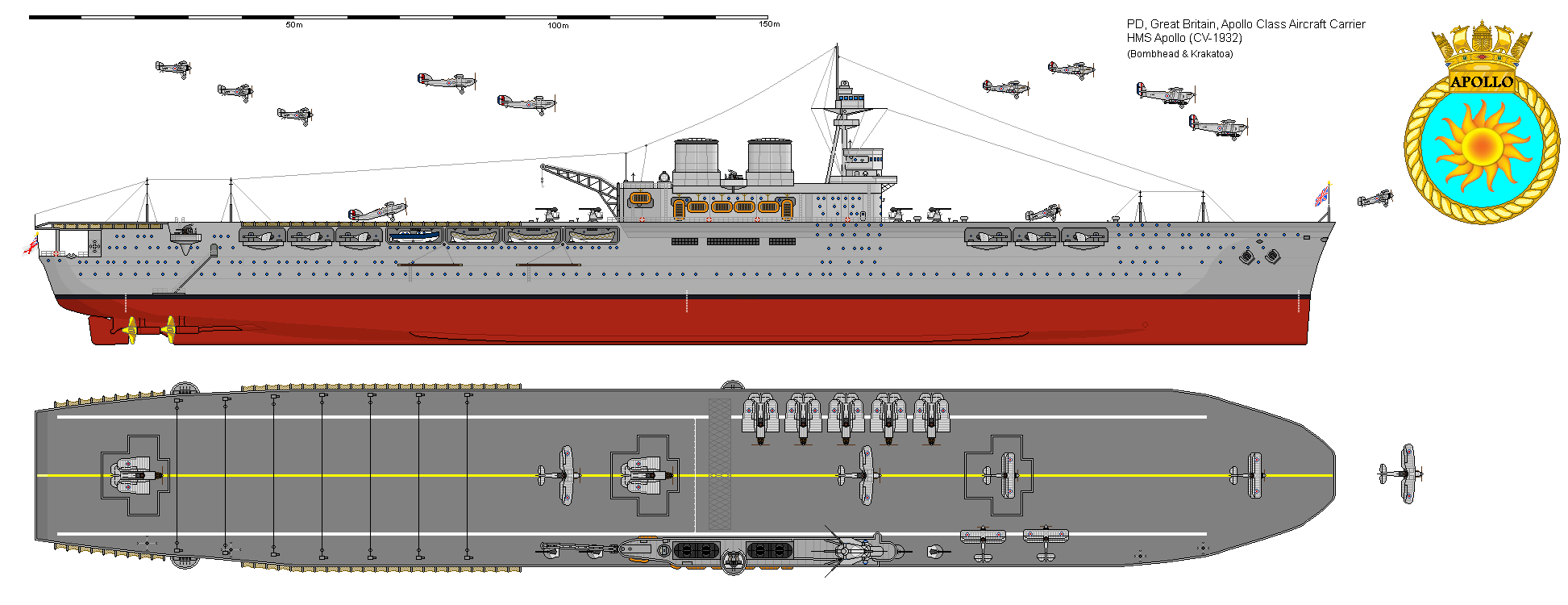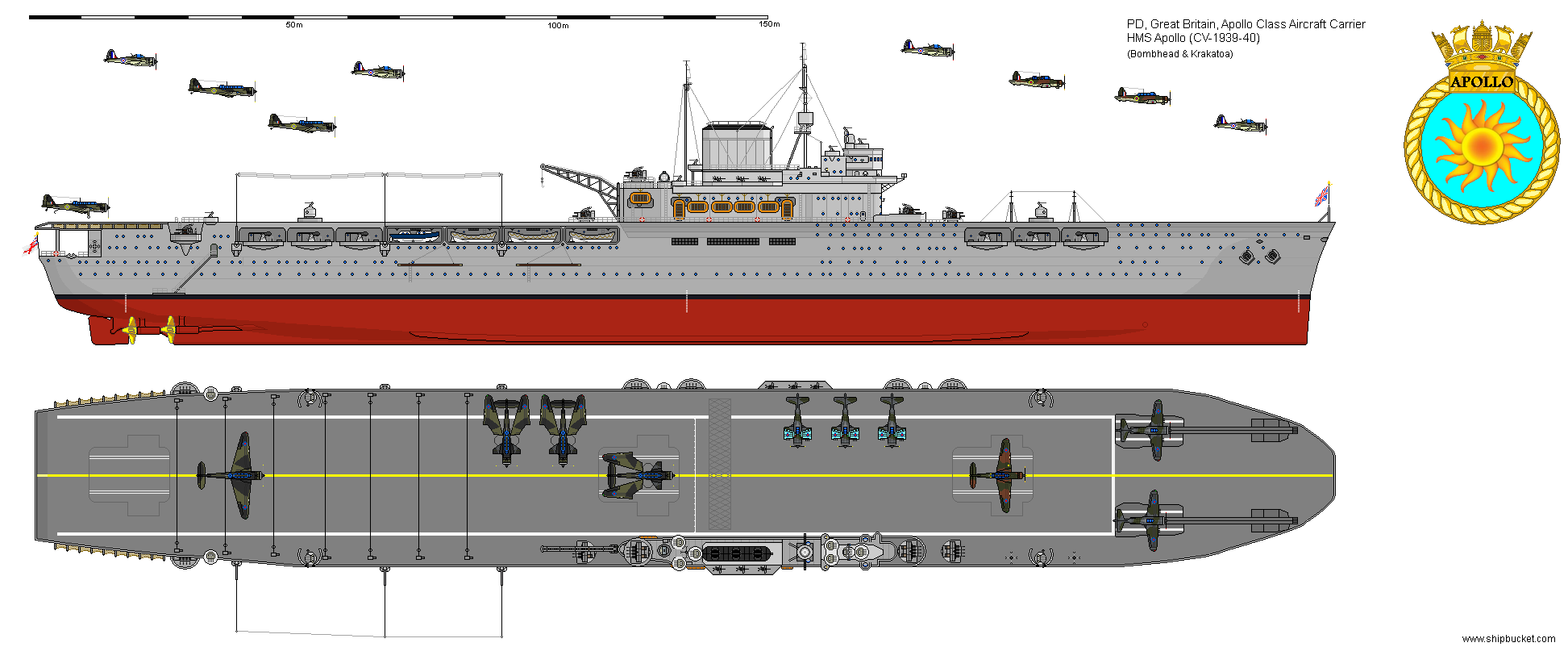
HMS
Apollo 1932
In Greek Mythology, Apollo is the big brother of Hermes. So it also proved
for the Royal Navy. The RN's first Washington Treaty Aircraft Carrier, the HMS
Apollo was an enlarged Hermes, utilising the information gained from operating
the early carriers. At just over 800 feet it was for some time the RN's largest
ship. Having only 27,000 standard tons to play with, something had to give to
get a ship 807 x 104 feet. What gave was armour. Only the most vital systems in
the ship were given armour coverage. Three inches of box armour were placed
around the armouries and propulsion systems.
As with most ships of the time a heavy gun armament was provided with 12 x 5.5"
as the main armament, with 4 x 4" AA guns and the new 2pd guns in octuple and
quadruple mounts. The aircraft were navalised versions of the equivalent land
based aircraft. The ship was designed to carry the maximum number of aircraft
internally and this equated to 76 aircraft (plus or minus 4-6 depending on size
and type. If the RN followed USN policy and included a deck park of aircraft to
the total, that would take the aircraft complement to 90-100 aircraft.

HMS Apollo with refits and additions through to 1940.

As can be seen when comparing the two versions, the later Apollo had the twin
funnels trunked together in 1937, in the same refit, the 5.5" guns were removed
and the single 4" guns fitted in their place. In 1938 the 2pd weapons were
greatly increased, the HACS units fitted to control the 4", the elevators
enlarged to take the Sea Battle torpedo bombers. 1939 the first RADAR outfit was
installed and more electronics were added to the ship as refits came due. This
takes the ship through to April 1940.
The Norwegian Campaign:
HMS Apollo was added to Admiral Whitworths squadron containing HMS Majestic and
HMS Warspite (BB's), HMS Hawkins, HMS Kent, HMS Surrey (CA's), with a dozen
destroyers. Their brief was to intercept German shipping in the Trondheim and
Narvik areas. The weather was appalling. The latest search radar on Majestic was
a godsend. Not only did it manage to spot enemy forces it allowed the Admiral to
'see' were his own ships were and keep some cohesive control over their
dispositions. Majestic 'saw' two large blips moving North at high speed, the
'chase' order was given but only Majestic and Apollo were able to match the
speed of the enemy ships and even they started dropping behind. Admiral
Whitworth called off the chase and the Scharnhorst and Gneisenau sailed off into
the Atlantic unaware of how close to being caught they had been.
While recalling his ships together a distress call was heard from HMS Gloworm
that had encountered the Hipper and its destroyer escorts. Kent, Surrey and four
destroyers were sent to intercept the Hipper and search for survivors. The
Hipper made it to Trondheim and secured the port and by the next morning had
secured the airfield which was then used by the Germans for air support missions
against the British ships. It was now that the Apollo came into its own. In a
dawn raid, the Apollo's aircraft caught the Hipper in harbour, putting a torpedo
into it and the Skuas hitting it twice with bombs. More Skuas and Griffons
attacked the airfield and caught the Germans on the ground, destroying the
aircraft and facilities with guns and bombs.
Kent, Surrey and the destroyers having missed the Hipper are ordered to sweep
north through the Inner leads up to Narvik. Admiral Whitworth and the main body
stay outside the Leeds and head north on a parallel course. The conditions have
not improved much outside in the Norwegian Sea and the weather has kept a lot of
the air superiority, gained by having the Apollo, is grounded aboard ship. The
Inner Leads Squadron (ILS) runs into a group of four German destroyers which
turn tail and dive back into Narvik fjord. Admiral Whitworth orders the ILS in
after them. The line is led by HMS Hardy (Captain Warburton-Lee), Hereward,
Surrey (Commodore Smith). Kent, Hero, Hotspur. (Anybody who has read the 'Smith'
series by Alan Evans will recognise my Commodore).
Unknown to the ILS there is actually now ten destroyers stuck in Narvik due to
lack of fuel. Conditions of low cloud and mist also hamper the squadrons
activities. The squadron went down the fjord at 15-20 knots per the Commodores
instructions. Passing one of the numerous cross fjords, the yell of torpedoes is
heard from the lookouts, what looked like a veritable shoal of eight torpedoes
burst out and onto the line of ships. Hardy and Hereward both received a torpedo
hit each. Hardy, hit in the stern uses its momentum to run ashore, the crew
flooding over the bow to the safety of dry land, then having to fight the German
lookout position that had signalled when to fire the torpedoes to the hidden
destroyer. That destroyer did not have much longer to live as in a brisk 5
minute action both Surrey and Kent hit the destroyer with multiple strikes that
ignited magazines and literally blew it out of the water. The Hereward with its
bows blown off managed to limp backwards out to where the bulk of the squadron
waited. It would be many months before Hereward would again be available for
service.
At the rate of loss of two to one the squadron would not last long even against
the three destroyers that the Commodore thought were left. The Commodore called
up the two pilots and asked for a volunteer for what could be a suicide mission,
launching a Walrus into the murk of that day. Both men stepped forward and the
Commodore selected the more experienced pilot. The Walrus is launched and
trundles down the fjord acting as the eyes of the fleet. This pays almost
immediate dividends with another ambush point being spotted. The lookout point
being blasted, the Hero went past the mouth of the fjord at 30 knots firing two
torpedoes, both of which hit the anchored German destroyer, turning it into a
sunken wreck. The Walrus had continued down the fjord while the squadron had
dealt with the ambush, but found no more ambushes. Reaching Narvik harbour
itself the observer sent warning that there were six more destroyers in harbour.
It was now that the two heavy cruisers proved their worth being able to use
standoff fire outside the range of the German destroyers 5" and using the Walrus
to spot for the shoot. The German destroyers made smoke to try to conceal
themselves but this was blown away in the windy conditions. Three more German
destroyers became total wrecks under the withering fire of the cruisers 7.5"
guns. The other three having varying degrees of damage. It was at this point
that the missing two German destroyers made an appearance firing torpedoes and
guns at the cruisers. A lucky torpedo hit on the Kent forced the remains of the
ILS squadron to withdraw. While damaged the Kent was still able to make 15
knots. So ended the First Battle of Narvik.
Offshore the weather started abating in the afternoon allowing the Apollo to
launch reconnaissance aircraft. These aircraft surveyed the Narvik fjord system
and noted the survivors of the Hardy. The remaining 5 damaged German destroyers
were all in Narvik Harbour. The aircraft sent to the north spotted the
Scharnhorst and Gneisenau returning from destroying the weather station on
Spitzbergen to support the destroyers in Narvik. Having seen they were spotted
and having lost the advantage of surprise and not knowing what was facing them,
the S&G followed their main orders and reversed course heading for the passes
out into the Atlantic. A strike force was sent out after S&G but was unable to
locate them before dusk. This left the dive bombers and a few fighters to attack
Narvik. The Hero was sent in to retrieve the Hardys survivors. The Narvik air
strike force met with heavy covering fire from the destroyers and the troops the
destroyers had landed. Despite this two more destroyers were sunk and two more
heavily damaged. Of the original ten German destroyers, only one effective unit
remained. An eventual decisive victory to the British forces.
At this point having spent almost two weeks at sea the ships of Admiral
Whitworths fleet were withdrawn to the Faeroes where replenishment ships were
waiting for them. During this passage the Apollo was torpedoed by a U-Boat.
Heavy damage and listing was not aided by a crew that had only been together for
six weeks. The ship was righted and being down by the stern was taken in tow by
the Surrey and with three destroyer escorts, headed for Rosyth and the safety of
a dockyard. This first service period of the Apollo had netted the damage to the
Hipper, the sinking of the destroyers in Narvik, and while the ship is in for
repair, the ships Skua dive-bombers finish off the damaged Hipper, sinking it
with a further 5 bomb hits.